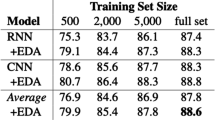Abstract
Bilingual word embeddings (BWEs) play a very important role in many natural language processing (NLP) tasks, especially cross-lingual tasks such as machine translation (MT) and cross-language information retrieval. Most existing methods to train BWEs are based on bilingual supervision. However, bilingual resources are not available for many low-resource language pairs. Although some studies addressed this issue with unsupervised methods, monolingual contextual data are not used to improve the performance of low-resource BWEs. To address these issues, we propose an unsupervised method to improve BWEs using optimized monolingual context information without any parallel corpora. In particular, we first build a bilingual word embeddings mapping model between two languages by aligning monolingual word embedding spaces based on unsupervised adversarial training. To further improve the performance of these mappings, we use monolingual context information to optimize them during the course. Experimental results show that our method outperforms other baseline systems significantly, including results for four low-resource language pairs.





Similar content being viewed by others
References
Ammar W, Mulcaire G, Tsvetkov Y, Lample G, Dyer C, Smith NA (2016) Massively multilingual word embeddings, arXiv preprint arXiv:1602.01925
Artetxe M, Labaka G, Agirre E (2016) Learning principled bilingual mappings of word embeddings while preserving monolingual invariance. In: Proceedings of the 2016 Conference on Empirical Methods in Natural Language Processing, pp 2289–2294
Artetxe M, Labaka G, Agirre E (2018) A robust self-learning method for fully unsupervised cross-lingual mappings of word embeddings. arXiv preprint arXiv:1805.06297
Barone AVM (2016) Towards cross-lingual distributed representations without parallel text trained with adversarial autoencoders. arXiv preprint arXiv:1608.02996
Bojanowski P, Grave E, Joulin A, Mikolov T (2017) Enriching word vectors with subword information. Trans Assoc Comput Linguist 5:135–146
Cao H, Zhao T, Zhang S, Meng Y (2016) A distribution-based model to learn bilingual word embeddings. In: Proceedings of COLING 2016, the 26th International Conference on Computational Linguistics: Technical Papers, pp 1818–1827
Cisse M, Bojanowski P, Grave E, Dauphin Y, Usunier N (2017) Parseval networks: Improving robustness to adversarial examples. In: Proceedings of the 34th International Conference on Machine Learning-Volume 70. JMLR. org, pp 854–863
Conneau A, Lample G, Ranzato M, Denoyer L, Jégou H (2018) Word translation without parallel data. arXiv preprint arXiv:1710.04087
Faruqui M, Dyer C (2014) Improving vector space word representations using multilingual correlation. In: Proceedings of the 14th Conference of the European Chapter of the Association for Computational Linguistics, pp 462–471
Goodfellow I, Pouget-Abadie J, Mirza M, Xu B, Warde-Farley D, Ozair S, Courville A, Bengio Y (2014) Generative adversarial nets. In: Advances in neural information processing systems, pp 2672–2680
Jagadeesha S, Sinha S, Mehra D (1994) A recursive modified gram-schmidt algorithm based adaptive beamformer. Signal process 39(1–2):69–78
Khan FH, Qamar U, Bashir S (2016) Sentimi: Introducing point-wise mutual information with sentiwordnet to improve sentiment polarity detection. Appl Soft Comput 39:140–153
Mikolov T, Le QV, Sutskever I (2013b) xploiting similarities among languages for machine translatio. arXiv preprint arXiv:1309.4168
Patra B, Moniz JRA, Garg S, Gormley MR, Neubig G (2019) Bilingual lexicon induction with semi-supervision in non-isometric embedding spaces. arXiv preprint arXiv:1908.06625
Ren S, Cao X, Wei Y, Sun J (2014) Face alignment at 3000 fps via regressing local binary features. In: Proceedings of the IEEE Conference on Computer Vision and Pattern Recognition, pp 1685–1692
Smith SL, Turban DH, Hamblin S, Hammerla NY (2017) Offline bilingual word vectors, orthogonal transformations and the inverted softmax. arXiv preprint arXiv:1702.03859
Strassel S, Tracey J (2016) Lorelei language packs: Data, tools, and resources for technology development in low resource languages. In: Proceedings of the Tenth International Conference on Language Resources and Evaluation (LREC’16). pp 3273–3280
Søgaard A, Ruder S, Vulić I (2018) On the limitations of unsupervised bilingual dictionary induction. arXiv preprint arXiv:1805.03620
Vulic I, Korhonen A-L (2016) On the role of seed lexicons in learning bilingual word embeddings
Xing C, Wang D, Liu C, Lin Y (2015) Normalized word embedding and orthogonal transform for bilingual word translation. In: Proceedings of the 2015 Conference of the North American Chapter of the Association for Computational Linguistics: Human Language Technologies, pp 1006–1011
Zhang M, Liu Y, Luan H, Sun M, Izuha T, Hao J (2016) Building earth mover’s distance on bilingual word embeddings for machine translation. In: Thirtieth AAAI Conference on Artificial Intelligence
Zhang M, Liu Y, Luan H, Sun M (2017b) Adversarial training for unsupervised bilingual lexicon induction. In: Proceedings of the 55th Annual Meeting of the Association for Computational Linguistics, Vol 1. ( Long Papers), pp 1959–1970
Zhang M, Peng H, Liu Y, Luan H, Sun M (2017a) Bilingual lexicon induction from non-parallel data with minimal supervision. In: Thirty-First AAAI Conference on Artificial Intelligence
Acknowledgements
This work is supported by the National Natural Science Foundation of China (61906158), the Project of Science and Technology Research in Henan Province (212102210075).
Author information
Authors and Affiliations
Corresponding author
Additional information
Publisher's Note
Springer Nature remains neutral with regard to jurisdictional claims in published maps and institutional affiliations.
Rights and permissions
About this article
Cite this article
Zhu, S., Mi, C., Li, T. et al. Improving bilingual word embeddings mapping with monolingual context information. Machine Translation 35, 503–518 (2021). https://doi.org/10.1007/s10590-021-09274-0
Received:
Accepted:
Published:
Issue Date:
DOI: https://doi.org/10.1007/s10590-021-09274-0




